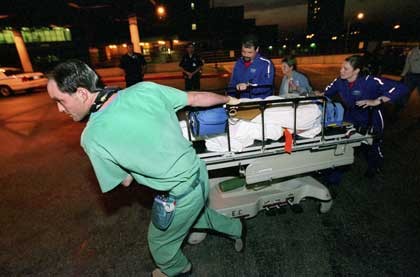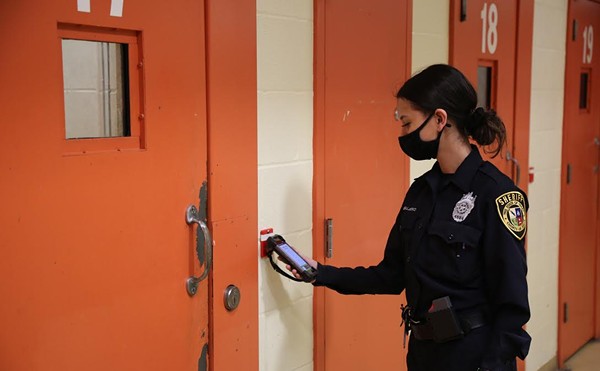If you’re sick and uninsured in Texas, better get used to standing in line
Ruth Espinoza works part-time in San Antonio and doesn’t qualify for healthcare benefits. She tried to get Medicaid, but she came into a little money after her husband’s death, so she earns too much to qualify. On Friday, she sat in the University Hospital’s Emergency Center waiting to be screened for a possible stroke, wondering how she will pay the bill.
| University Hospital and Airlife personnel rush a critically injured patient into the hospital's trauma center. |
“I have kids growing up that I have to care for and can’t afford insurance,” Espinoza said. “I don’t know why I didn’t qualify for Medicaid, because I’m a low-income person.”
About 50 patients fill the ER waiting room around 7 p.m. each day — the prime hour for business. And by 3:30 p.m. on the day the Current visited, almost every seat was already full. During evening hours, says Ernest Prince, a charge nurse who works in the ER, it’s standing-room-only, in some cases up to 24 hours.
“I hate to admit it, but sometimes I’ll walk in the ER and see the same person in the waiting room that was there yesterday morning,” Prince said. “When you see someone like that, you know that they are really sick.”
Since hospitals see the sickest patients first, those with abdominal pain, headaches, and other less-immediate concerns usually wait the longest.
But a long wait won’t deter someone who, say, can’t afford to pay for diabetes medicine and faces possible blindness, amputation, and heart attack, or an uninsured person who can’t afford a trip to the dentist, and winds up in the ER with a pus-filled abscess.
A recent University of Texas health report says, and most health-care watchdogs agree, that the uninsured are more likely to be hospitalized for problems that could have been taken care of through a primary-care doctor.
Primary physicians, including dentists, provide preventative medicine, which serves as a screen to catch diseases in the early stages. Without access to checkups, those with cancer, for example, may not know of their illness until it’s too late.
In compliance with the 1986 Emergency Medical Treatment and Labor Act, all Medicare-participating hospitals must provide the public with access to their services, regardless of their ability to pay at the ER at the time the services are rendered. This doesn’t apply to primary-care doctors, who actually cost, on average, three times less than a trip to the ER.
“Everyone has gone to a doctor’s office and seen the sign, ‘You must pay before you leave’ on the door,” says Prince. “If an uninsured person sees that, they turn back around and come here ... Some people think the county hospital is free.”
Texas leads the nation in percentage of uninsured residents with a full 25 percent of the population according to the U.S. Census. More patients are clogging Texas ERs, waiting longer hours, paying more money, and finding themselves at risk for serious health problems than anywhere else in the country. And that’s saying nothing about the quality of today’s ER care.
University Hospital spokeswoman Leni Kirkman points to a computer screen showing services the hospital can still provide, along with those that are completely full. When the specialized physicians are busy with other patients, new arrivals must be diverted to another hospital system in the area. Kirkman said University diverts its ambulances 65 percent of the time.
Imagine the confusion when family and friends are told their loved one went to University, only to arrive and find out they’re not there.
Hospital staff said ER services can back up so much that the ambulance driver doesn’t know where to go because he has already been diverted from more than one hospital.
“When the hospital has to divert ambulances, it wastes valuable time that we could’ve been helping the person in need,” Kirkman said.
Another problem plaguing the ER is bed availability. Patients must be kept in an ER bed while waiting for one to open up on the surgical floor. This process, called “boarding,” makes ailing people in the ER lobby sit, or stand, even longer.
“You can’t let a sick person wait in the hallway while we put another patient in the room,” Kirkman said.
When the Current visited University, 36 people were in the waiting room, and only one bed was open. Another four people had been assigned a bed, but were waiting to be admitted to surgery upstairs. Most days, staffers said, as many as 30 people get fed up with waiting and leave.
Though these problems are evident every day at Texas hospitals, the state legislature in 2003 cut $1.9 billion from Medicaid and CHIP health-care programs. This eliminated assistance for about180,000 children and 20,000 adults, according to a report provided by the San Antonio-based Methodist Healthcare Ministries. After a public outcry, some health-care funding was restored, but not to the extent the programs received pre-2003.
“When you’re one of the wealthier states in the nation, and one of the least in spending for health care, that’s telling Texans that their health isn’t a priority,” said Kevin Moriarty, Methodist Healthcare’s chief executive officer.
And since the federal government matches state dollars for programs such as Medicaid, when Texas cuts funds, so do the feds.
“New York, California, and other states are taking our federal dollars because we aren’t pulling our fair share on the state level,” said Joe Babb, Methodist Healthcare’s executive director.
Community nonprofits are trying to open more health clinics that can provide reduced-cost care for the uninsured. The Dr. Frank Bryant Health Center, 3066 E. Commerce St., opened in fall 2005 and provides dental, mental-health, and pediatric services along with a basic family practice.
Some 80 percent of the people who use its pharmacy are uninsured.
“We pride ourselves in that our services treat patients just like any doctor’s office in any part of town,” said Michael De La Garza, spokesman for the CommuniCare Health Centers, to which Bryant clinic belongs. “We keep everything clean and our doctors aren’t volunteers, they are trained professionals, as good as any doctor in San Antonio.”


















